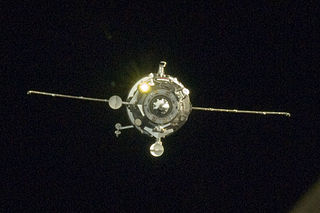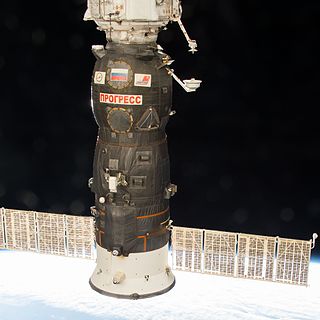
Mir was a space station that operated in low Earth orbit from 1986 to 2001, operated by the Soviet Union and later by the Russian Federation. Mir was the first modular space station and was assembled in orbit from 1986 to 1996. It had a greater mass than any previous spacecraft. At the time it was the largest artificial satellite in orbit, succeeded by the International Space Station (ISS) after Mir's orbit decayed. The station served as a microgravity research laboratory in which crews conducted experiments in biology, human biology, physics, astronomy, meteorology, and spacecraft systems with a goal of developing technologies required for permanent occupation of space.

The Shuttle–Mir program was a collaborative 11-mission space program between Russia and the United States that involved American Space Shuttles visiting the Russian space station Mir, Russian cosmonauts flying on the Shuttle, and an American astronaut flying aboard a Soyuz spacecraft to engage in long-duration expeditions aboard Mir.

Buran was the first spaceplane to be produced as part of the Soviet/Russian Buran program. Buran completed one uncrewed spaceflight in 1988, and was destroyed in 2002 due to the collapse of its storage hangar. The Buran-class orbiters used the expendable Energia rocket, a class of super heavy-lift launch vehicle. Besides describing the first operational Soviet/Russian shuttle orbiter, "Buran" was also the designation for the entire Soviet/Russian spaceplane project and its flight articles, which were known as "Buran-class orbiters".

Spektr was the fifth module of the Mir Space Station. The module was designed for remote observation of Earth's environment containing atmospheric and surface research equipment. Spektr also had four solar arrays which generated about half of the station's electrical power.

Kurs is a radio control system used by the Soviet and later Russian space program.

Expedition 25 was the 25th long-duration mission to the International Space Station (ISS). Expedition 25 began with the Soyuz TMA-18 undocking on 25 September 2010. Three new crewmembers arrived aboard the ISS 10 October 2010 on Soyuz TMA-01M to join Douglas Wheelock, Fyodor Yurchikhin and Shannon Walker, and formed the full six member crew of Expedition 25. NASA astronaut Doug Wheelock accepted command of Expedition 25 on 22 September 2010, taking over from Russia's Aleksandr Skvortsov. The departure of Wheelock, Walker and Yurchikhin on 25 November 2010 marked the official end of Expedition 25.

Progress M-01M, identified by NASA as Progress 31P, was a Progress spacecraft used to resupply the International Space Station. It was the first flight of the Progress-M 11F615A60, which featured a TsVM-101 digital flight computer and MBITS digital telemetry system, in place of the earlier analogue systems. It was the first Progress-M 11F615A60 spacecraft, and had the serial number 401.

Progress M1-5 was the Progress spacecraft which was launched by Russia in 2001 to deorbit the fifteen-year-old Mir space station in a controlled fashion over a remote area of the southern Pacific Ocean otherwise Mir's orbit would have decayed uncontrolled over time, with debris potentially landing in a populated area. The Russian Aviation and Space Agency, Rosaviakosmos, was responsible for the mission.
Progress M-67 was a Progress spacecraft which was used for the Progress 34P flight to resupply the International Space Station. It was a Progress-M 11F615A55 spacecraft, with the serial number 367. Its flight to the ISS marked the final flight of the Progress-M 11F615A55 model, which was retired in favour of the modernised Progress-M 11F615A60.
Progress M-15 was a Russian uncrewed cargo spacecraft which was launched in 1992 to resupply the Mir space station. The thirty-third of sixty-four Progress spacecraft to visit Mir, it used the Progress-M 11F615A55 configuration, and had the serial number 215. It carried supplies including food, water and oxygen for the EO-12 crew aboard Mir, as well as equipment for conducting scientific research, and fuel for adjusting the station's orbit and performing manoeuvres. It also transported the Mak 2 satellite, which was deployed from Mir on 20 November. TORU manual docking system was first tested in this mission.

Progress M-05M, identified by NASA as Progress 37P, is a Progress spacecraft launched by the Russian Federal Space Agency in April 2010 to resupply the International Space Station (ISS). The spacecraft carried fresh food and supplies for the ISS crew. Progress M-05M also hauled some special care packages for the station crew that included confectioneries, books and new movies.

Progress M-06M, identified by NASA as Progress 38P, is a Russian Progress spacecraft which was launched in June 2010 to resupply the International Space Station. It was the 38th Progress to dock with the space station and the third of year 2010.

Progress M-08M, identified by NASA as Progress 40P, is a Progress spacecraft which was used to resupply the International Space Station. It was the eighth Progress-M 11F615A60 spacecraft to be launched, the fifth for the year 2010. The spacecraft was manufactured by RKK Energia, and was operated by the Russian Federal Space Agency. It arrived at the space station on 30 October 2010 whilst the Expedition 25 crew was aboard, and departed during Expedition 26 on 24 January 2011.

Progress M-34 was a Russian uncrewed cargo spacecraft which was launched in 1997 to resupply the Mir space station, and which subsequently collided with Mir during a docking attempt, resulting in significant damage to the space station.

Progress M-24 was a Russian uncrewed cargo spacecraft which was launched in 1994 to resupply the Mir space station; causing minor damage to the station as the result of a collision during a failed attempt to dock.

Progress M-17M, identified by NASA as Progress 49P, was a Progress spacecraft used by Roskosmos to resupply the International Space Station during 2012. The seventeenth Progress-M 11F615A60 spacecraft to launch, it had the serial number 417 and was built by RKK Energia. It was the 130th launch to the ISS and the twentieth Russian space launch in 2012. It was also the eleventh mission for the R-7 family of rockets since the beginning of the year.

Progress MS-01, identified by NASA as Progress 62P was a Progress spaceflight operated by Roscosmos to resupply the International Space Station (ISS) in 2015. It was launched on 21 December 2015, to deliver cargo to the ISS. Progress MS-01 is the first vehicle in the Progress-MS series.

Progress MS-05, identified by NASA as Progress 66P, was a Progress spaceflight operated by Roscosmos to resupply the International Space Station (ISS).

Progress MS-15, Russian production No. 444, identified by NASA as Progress 76P, was a Progress spaceflight operated by Roscosmos to resupply the International Space Station (ISS). This was the 167th flight of a Progress spacecraft.

















